
Image 010250-02-01
Used between 1899 and 1909.
The factory was founded under the promising name 'Fortuna' in 1898 by Schmuck, Welsch and Klein, three businessmen who actually had no experience in porcelain making at all, resulting in dire problems straight from the start. After only a year, the company went bankrupt and was bought out by Emanuel Gareis, Joseph Kühnl, Moritz Reis and Philipp Rosenau.
While Reis and Rosenau took over the financial part, both Gareis and Kühnl took over production. Both originally came from the Karlsbad (Bohemia) area and their extensive knowledge helped the new business get on its way. Only a year later Gareis left the company and was replaced by Karl Pleier, a former stonemason from Pechgrün near Chodau (Bohemia). In 1903, Kühnl left the company after introducing Adolf Stark, who became technical manager. Stark was a charismatic character and a perfect addition to the company. Being responsible for an impressive surge in ideas and products, he also became shareholder in 1904 and soon afterwards became general director.
Over the next few years, the business slowly expanded and soon had eight kilns, mainly producing tableware. The technical side of this expansion period included two new steam engines (one 50hp, one 120hp), both produced by the Maschinenbau-Aktiengesellschaft Marktredwitz (the former Maschinenfabrik Heinrich Rockstroh), delivered and installed in 1907. A third steam engine was later ordered at the M.A.N. Maschinenfabrik Augsburg-Nürnberg AG, and that 200/265hp engine was installed on April 25th 1921.
After twenty years of successfully leading the company, Stark retired in 1924 and his son Hans Stark as well as Karl Pleier jun. took over as managing directors. Under their leadership the company flourished even more, requiring an increase of workforce from around 300 in 1925 to 450 in 1930. As the first waves of Nazi propaganda had openly lead to protest against Jewish businessmen in 1936 both Reis and Rosenau left Germany and emigrated to the US, leaving Stark and Pleier jun. in charge. Slowly but surely Germany geared for war, resulting in a drop of orders which was compensated by cutting the workforce down to around 200 people in 1937.
The war years came along with the typical problems like shortages in both workforce and raw materials, but even more shattering was the total collapse of the export market which made up a large part of the business. Especially Pleier jun. tried everything to keep business alive. The stress he put on himself proved too much and by the time the war was over he had ruined his health beyond repair, dying in 1946. A strong personality like his father, Hans Stark continued alone and not only managed to evade bankruptcy but improved business in record time, leading to the business transformation into a corporation in 1950.
After the transformation Hans Stark continued as chief executive and one of his last actions was to have the first tunnel kiln built in 1954 as last step of a modernization plan. In the same year, the shareholders living in the US sold off their shares which were distributed evenly between the German shareholders and Mr. Emil Engel, proprietor of the Franz Kassecker construction company in Waldsassen.
Even though the company was still successfull over the next years, business slowly declined. Not being able to bring forward a strong leading personality like Stark, the directors - driven by Emil Engel - finally decided to merge with the Porzellanfabrik Waldsassen Bareuther & Co. AG in 1969. It should be noted that the factory itself remained operational as subsidiary until the Bareuther & Co. AG was forced close in 1994.
Special thanks go to former employee Mr. H. Schmidt who helped to solve the mysteries regarding a few marks which were not included in common mark references.

Image 010250-02-01
Used between 1899 and 1909.
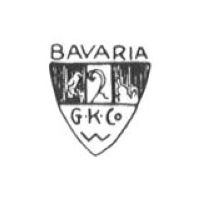
Image 010250-02-02
Used from around 1900 until 1930.
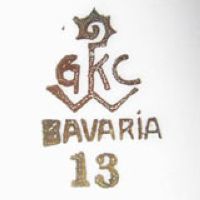
Image 010250-02-03
Used between 1900 and 1945, in gold.
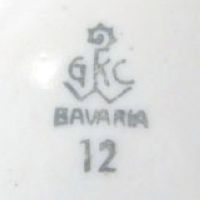
Image 010250-02-04
Used between 1900 and 1945, here in dark green.
(Picture: Jacqueline Kacprzak)
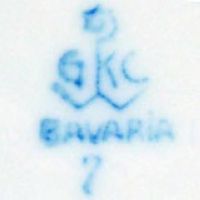
Image 010250-02-05
Used between 1900 and 1945, in blue.
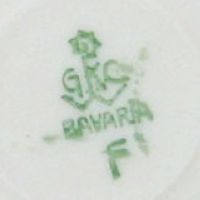
Image 010250-02-06
Used between 1900 and 1945, here a bright green version.
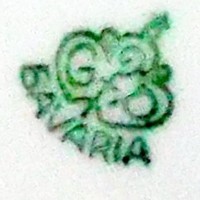
Image 010250-02-07
Used between 1905 and 1909, including the stylized bishop's staff (crozier); few series only.
(Picture: Peter Holland)
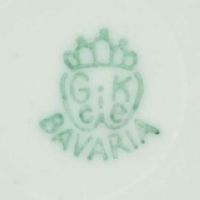
Image 010250-02-08
Used between 1909 and 1921, with "GK" and the abbreviation Cie.
(Picture: Terri Ruggiero)
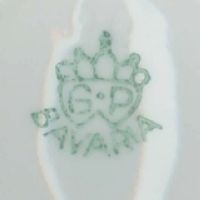
Image 010250-02-09
Used between 1909 and 1921, the "GP" stands for "Gareis Porzellan".
(Picture: Terri Ruggiero)
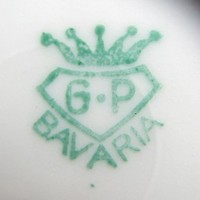
Image 010250-02-10
Used between 19xx and 19xx. Plain, minimalistic mark form.
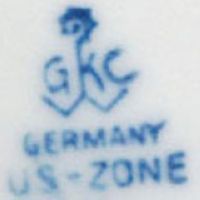
Image 010250-03-01
Used between 1946 and 1949.
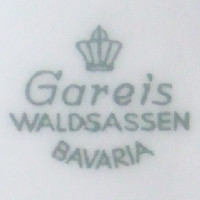
Image 010250-03-02
Used between 1950 and 1969, either in dark green or greyish-green (like this example).
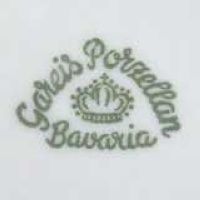
Image 010250-03-03
Used after 1950 but no exact dates known, "Gareis Porzellan Bavaria".
© 2004-2024 C.S.Marshall, all rights reserved